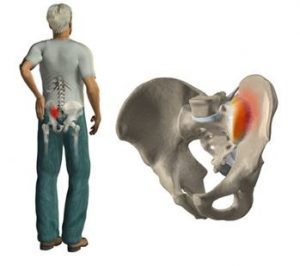Sport Rehabilitation and Physiotherapy for Sacroiliac Joint Dysfunction

What is the Sacroiliac joint?
The joints on both sides of the sacrum connecting this bone to the pelvis. The irregular joint surfaces, strong ligaments and surrounding muscles provide the joint with great stability for weight bearing but restrict any unwanted movement.
What is a Sacroiliac joint dysfunction?
It is ‘subluxation’ of the joint (moved out of the correct position) usually due to direct trauma such as falling from a height or slipping downstairs. There are several factors that can contribute to this dysfunction which include: leg length discrepancy (one leg longer than the other), abnormalities in walking or running patterns, prolonged vigorous exercise, abnormal curvature of the spine and changes in low back posture. It is also common during pregnancy due to hormone induced ligament laxity.
What are the symptoms of a Sacroiliac joint dysfunction?
Pain and muscle spasm around the joint and symptoms may spread to the buttock, groin, back, thigh, or calf. Static postures such as sitting, standing and sleeping can cause pain so you may have disturbed sleep and early morning stiffness. Increased weight bearing activities and lying on the affected side can also increase symptoms.
What treatments are most commonly used for a Sacroiliac joint dysfunction?
Massage – Encompassing a variety of techniques and is given with sufficient pressure through the superficial tissue to reach the deep lying structures. It is used to increase blood flow, decrease swelling, reduce muscle spasm and promote normal tissue repair.
Mobilisation – Is a manual technique where the joint and soft tissues are gently moved by the therapist to restore normal range, lubricate joint surfaces, and relieve pain.
Manipulation – Is a high speed, short movement thrust given at the end of available range. It is used to break down adhesions, remove a blockage within a joint and restore full painless movement. A click or noise may be experienced during this treatment
Ultrasonic therapy – Transmits sound waves through the tissues stimulating the body’s chemical reactions and therefore healing process, just as shaking a test tube in the laboratory speeds up a chemical reaction.
Interferential therapy – Introduces a small electrical current into the tissues and can be used at varying frequencies for differing treatment effects. E.g. pain relief, muscle or nerve stimulation, promoting blood flow and reducing inflammation.
What other treatments could be used for a Sacroiliac joint dysfunction?
Acupuncture – An oriental technique of introducing needles into the skin to increase or decrease energy flow to promote pain relief and healing.
What can you do yourself to help a Sacroiliac joint dysfunction?
Exercise programme – This is the most important part of the rehabilitation. Your therapist will instruct you as to which exercises to begin with, when to add the others, as well as how to progress the exercises.
Medication – Ask your GP or Pharmacist for advice on the best medication for your condition.
Heat packs – The application of a hot pack may be beneficial in helping the muscles to relax, promote blood flow to the area and provide pain relief.
Posture – Good posture enables the muscles of the spine to act as a supporting structure and decreases the strain on the joints of the spine.
Ergonomics – Ensure that all your seating is encouraging you to attain good posture and your mattress is supporting your spine adequately.
What if treatment does not help or resolve a Sacroiliac joint dysfunction?
It is very rare that therapy does not give great benefit. In these cases onward referral to a spinal consultant may be appropriate which can be discussed with your therapist.
If you think you may have this condition we would love the opportunity to show you our expertise in the treatment and management of this condition so – Please click here for details of how to contact us to book an appointment
If you are unsure whether you have this condition or you would just like to speak to somebody then please get in touch here or call 0161 745 7551 or 0151 515 2323.
